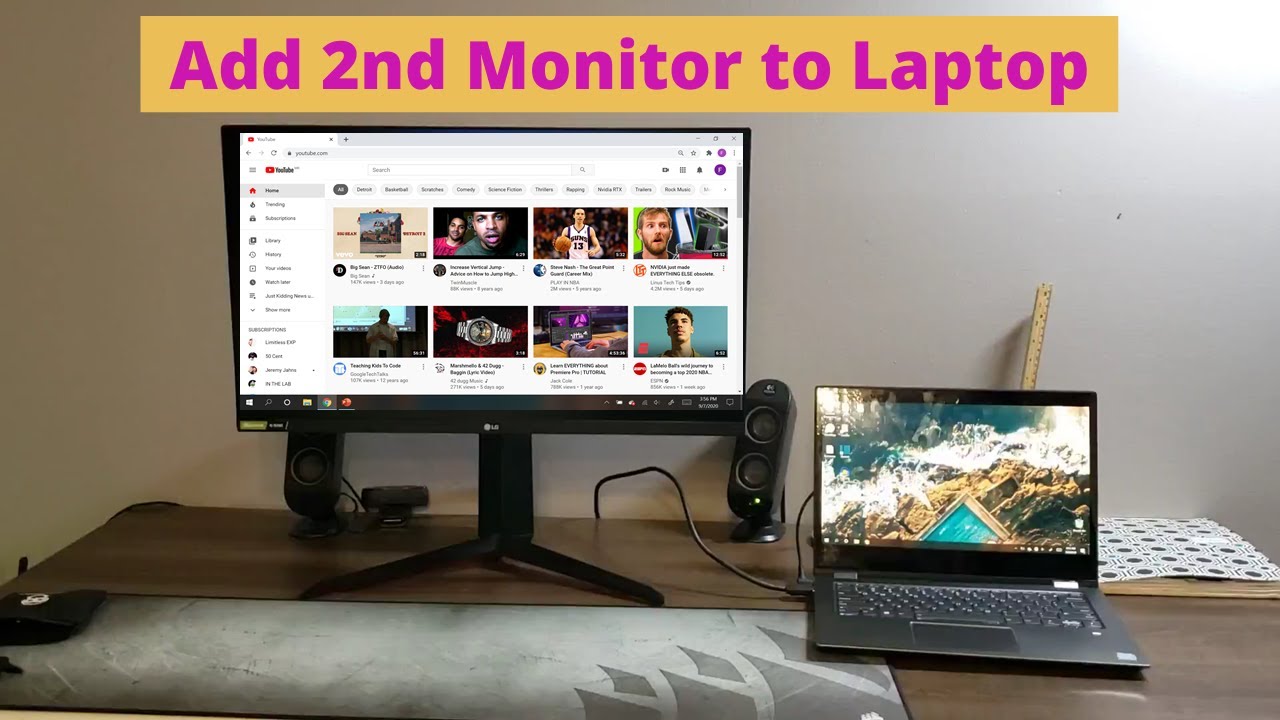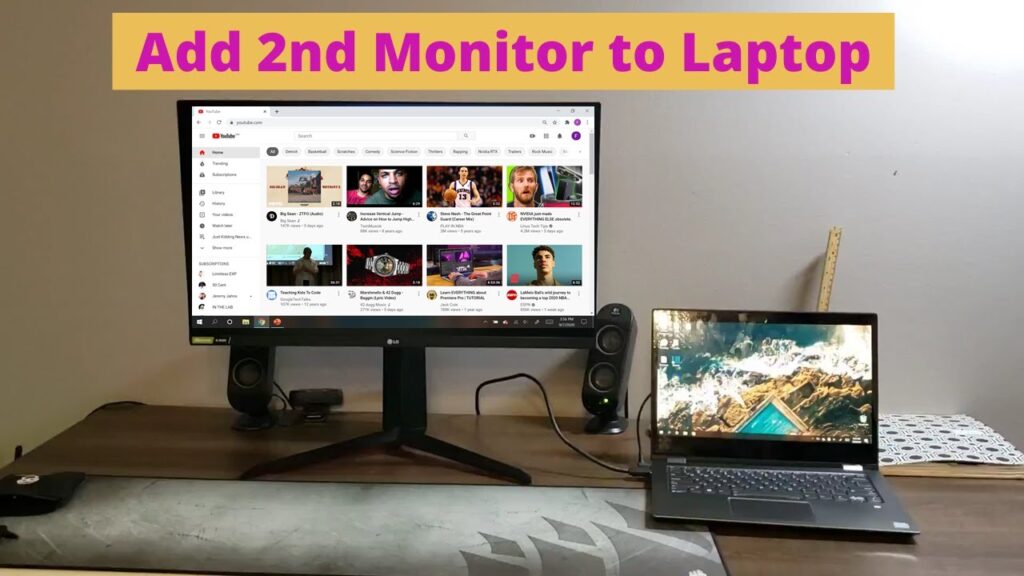
Hey there, it’s your buddy Philip J! With so many people working from home lately, it’s become essential to find ways to increase productivity. And one of the best ways to do that is by adding a second screen to your laptop. Let’s face it, the screens on laptops are on the smaller side, like the 14-inch one I’m using right now. If you have a 15.5-inch or 12-inch laptop, it’s just not gonna cut it. So, in this article, I’m going to show you how to connect a second monitor to your laptop for that much-needed dual monitor setup.
To get started, here’s what you’ll need: your laptop, a display cable (in my case, it’s HDMI), and a monitor. Firstly, let’s talk about the type of cable you need. Check the ports on your laptop. I have an HDMI port and a USB port on one side, and on the other side, I have an SD card slot and another USB port. The HDMI cable is what I can use to display video on the laptop. There are other types of cables you can use, like DisplayPort or DVI, but HDMI is the most commonly used. Make sure to also check the ports on your monitor. Once you have your cable and monitor ready, connect one side of the cable to your laptop and the other side to the monitor. Then, turn on the monitor and access the monitor settings to select the correct port you plugged the cable into. On your laptop, go to display settings, where you can set up your dual monitor display. You can choose to duplicate the displays, extend them, or show only one screen. Just keep in mind which screen you want to be your main display, as that’s where all your applications will show up. And voila, you now have a dual monitor setup to boost your productivity.
How to Connect a Second Monitor to Your Laptop
Adding a second monitor to your laptop can greatly increase your productivity, especially when working from home. Laptop screens are usually smaller, making it difficult to multitask effectively. By connecting an extra monitor, you can expand your workspace and have multiple applications open simultaneously. In this article, we will guide you through the process of connecting a second monitor to your laptop and setting it up for dual monitor use.

This image is property of i.ytimg.com.
Check the Ports on Your Laptop
Before you begin, it’s important to check the ports on your laptop to determine the type of cable you need. Different laptops have different port options, such as HDMI, USB, DisplayPort, or DVI. Pay attention to the size and type of ports available on your laptop. For example, if your laptop has an HDMI port, you will need an HDMI cable to connect it to your monitor.
Types of Cables for Video Display
There are several types of cables you can use to display video from your laptop to the monitor. These include HDMI, DisplayPort, DVI, and more. However, HDMI is the most commonly used and widely available option. It provides high-definition video and audio signals, making it ideal for connecting your laptop to a monitor.
Connect One End to Your Laptop
Once you have identified the type of cable you need, it’s time to connect it to your laptop. Plug one end of the cable into the corresponding port on your laptop. Ensure a secure and snug connection to avoid any signal interruptions.
Connect the Other End to Your Monitor
After connecting one end of the cable to your laptop, take the other end and connect it to your monitor. Again, make sure the connection is secure. Depending on the type of cable and monitor, you may need to adjust the locking mechanisms or screws for a proper fit.
Turn On the Monitor
With the cable connected to both your laptop and monitor, you can now turn on the monitor. Press the power button to activate the display.
Accessing the Input Settings on Your Monitor
Once the monitor is powered on, you need to access the input settings to choose the correct input port. Use the buttons or menu options on your monitor to navigate to the input settings. Select the input port that corresponds to the cable you plugged in, such as HDMI 1 or HDMI 2.
Accessing Display Settings on Your Laptop
Next, you’ll need to access the display settings on your laptop. Right-click on your desktop and select “Display settings” from the dropdown menu. This will open the display settings window, allowing you to customize your dual monitor setup.
Identifying the Connected Displays
In the display settings window, you will see a diagram representing your dual monitor setup. It will show your laptop and the connected monitor as separate displays. To identify which display is which, click on the “Identify” button. This will display a number on each screen, indicating its position in the setup.
Choosing the Display Resolution
In the display settings window, you can also adjust the display resolution for your laptop and the connected monitor. The resolution determines the clarity and sharpness of the visuals on each screen. You may notice that the resolution on your laptop is smaller than that of the monitor. This is because laptop screens often have lower resolutions. Adjust the resolution settings according to your preferences and the capabilities of your monitor.
Options for Multiple Displays
Under the display settings, you will find various options for multiple displays. One of the options is to duplicate the displays. This means that whatever you do on one screen will be shown simultaneously on the other screen. This is useful for presentations or when you want to share the same content on both screens.
How Duplicate Displays Work
When you choose the duplicate displays option, any action you perform, such as opening an application or moving the mouse cursor, will be mirrored on both screens. This allows you to easily share information or work on the same content simultaneously.
Using Duplicate Displays for Simultaneous Output
Duplicate displays work best when you need to project your laptop screen onto a larger monitor or when you want to share your screen with someone else. It can be useful in meetings, classrooms, or when collaborating with colleagues. Simply connect your laptop to the monitor, choose the duplicate display option, and your content will be visible on both screens.
How Extended Displays Work
Another option in the display settings is to extend the displays. With extended displays, each screen functions independently, and you can have different applications or content on each screen. This is ideal for multitasking and increasing your productivity.
Using Extended Displays for Dual Monitor Setup
When you choose the extend displays option, you can drag applications or windows from one screen to the other. This allows you to spread out your work across multiple screens and easily switch between tasks. You can have a document open on one screen while referencing a website or email on the other screen.
Selecting the Main Display
In the display settings, you have the option to select the main display. The main display is the primary screen where your desktop icons, taskbar, and most applications will appear. By default, your laptop screen is usually set as the main display. However, you can change this setting and make the connected monitor your main display if desired.
Moving Applications to the Main Display
If you have set the connected monitor as your main display, you may need to move some of your applications from the laptop screen to the main display. To do this, simply drag the application window from one screen to the other. You can also right-click on the application window and select “Move to” to choose the desired screen.
Changing the Screen Arrangement
If you find that the screen placement is not aligned with your physical setup, you can adjust the screen arrangement in the display settings. Click on the display that you want to move and drag it to the desired side. This allows you to match the position of your screens with their physical placement on your desk.
Maintaining Proper Screen Resolution
It’s important to ensure that both your laptop and the connected monitor are set to their optimal screen resolutions. A mismatch in resolution can result in blurry or distorted visuals. Double-check the resolution settings in the display settings window and adjust them if needed.
Ensuring Both Displays Are Recognized
If you encounter any issues with your dual monitor setup, such as one display not being detected, make sure that all connections are secure. Check the input settings on your monitor to ensure that the correct input port is selected. Additionally, you can try restarting your laptop or updating your display drivers to troubleshoot any connectivity issues.
Correcting Screen Placement Issues
If you’re experiencing difficulties with the mouse cursor not moving smoothly between screens or the screen placement feeling unnatural, you may need to adjust the screen arrangement. Experiment with different screen positions until you find the most comfortable setup for your workflow.
Conclusion
Adding a second monitor to your laptop can significantly enhance your productivity and improve your multitasking capabilities. By following the steps outlined in this article, you can easily connect and set up a dual monitor configuration. Whether you choose to duplicate displays for simultaneous output or extend displays for a dual monitor setup, the flexibility and expanded workspace provided by a second monitor will undoubtedly benefit your work or entertainment experience.
To connect a second monitor to your laptop and use it as a dual monitor, follow these steps:
- Start by gathering the necessary cables. You may need an HDMI cable, a DVI to HDMI cable, a DVI cable, a DisplayPort to HDMI cable, a DisplayPort cable, a USB-C to HDMI cable, or a USB-C to DisplayPort cable. You can find these cables on Amazon using the links provided below.
- HDMI Cable: HDMI Cable
- DVI to HDMI Cable: DVI to HDMI Cable
- DVI Cable: DVI Cable
- DisplayPort to HDMI Cable: DisplayPort to HDMI Cable
- DisplayPort Cable: DisplayPort Cable
- USB-C to HDMI Cable: USB-C to HDMI Cable
- USB-C to DisplayPort Cable: USB-C to DisplayPort Cable
- Once you have the cables, connect one end to your laptop’s video output port and the other end to the corresponding port on the second monitor.
- Turn on your laptop and the second monitor.
- Go to your laptop’s display settings. You can usually access this by right-clicking on your desktop and selecting “Display settings” or “Screen resolution.”
- In the display settings, look for the option to “Extend” your display. This will allow you to use the second monitor as a dual monitor setup.
- Follow the on-screen instructions to complete the setup and adjust the display settings to your preference.
- You can now use your second monitor alongside your laptop screen for increased productivity or expanded workspace.
For more related videos on laptop and monitor connections, you can check out the following links:
- Connect Laptop to TV: Connect Laptop to TV
- Close Laptop Lid and Still Work on Monitor: Close Laptop Lid and Still Work on Monitor
- How to Connect a MacBook to Monitor: How to Connect a MacBook to Monitor
If you need further assistance or have business inquiries, you can email Filip Tech at filipjtech@gmail.com.
Please note that purchases made through the provided Amazon links may provide compensation to Filip Tech.






